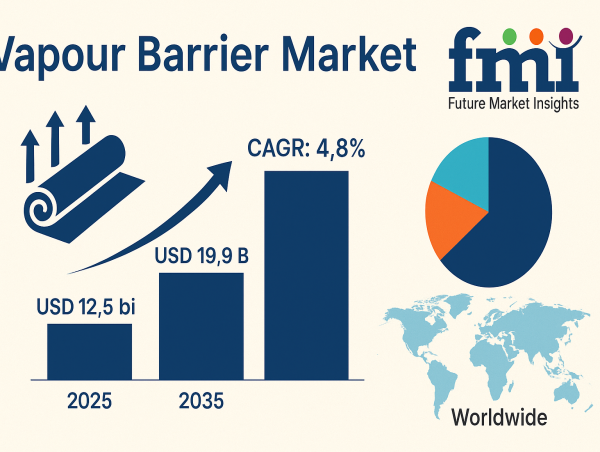𝐔𝐧𝐝𝐞𝐫𝐬𝐭𝐚𝐧𝐝𝐢𝐧𝐠 𝐌𝐨𝐢𝐬𝐭𝐮𝐫𝐞 𝐌𝐢𝐠𝐫𝐚𝐭𝐢𝐨𝐧: 𝐖𝐡𝐲 𝐎𝐧𝐞 𝐁𝐚𝐫𝐫𝐢𝐞𝐫 𝐃𝐨𝐞𝐬𝐧’𝐭 𝐅𝐢𝐭 𝐀𝐥𝐥 𝐂𝐥𝐢𝐦𝐚𝐭𝐞𝐬
Humidity variability and climate differences mean that a single vapour barrier solution is not universally applicable. In hot-humid zones such as Florida or Southeast Asia, external vapour drive creates internal moisture buildup, requiring outward-breathable but inward-resisting barrier films. Conversely, cold climates prioritize the prevention of indoor humidity from reaching colder outer walls where condensation can occur. This makes the case for region-specific moisture control strategies, highlighting the limitations of generic polyethylene film barriers. Engineers and architects are increasingly turning to climate-specific vapour retarders that adapt to dew point variations.
𝐌𝐚𝐤𝐞 𝐈𝐧𝐟𝐨𝐫𝐦𝐞𝐝 𝐃𝐞𝐜𝐢𝐬𝐢𝐨𝐧𝐬 – 𝐀𝐜𝐜𝐞𝐬𝐬 𝐘𝐨𝐮𝐫 𝐒𝐚𝐦𝐩𝐥𝐞 𝐑𝐞𝐩𝐨𝐫𝐭 𝐈𝐧𝐬𝐭𝐚𝐧𝐭𝐥𝐲! https://www.futuremarketinsights.com/reports/sample/rep-gb-3084
𝐒𝐦𝐚𝐫𝐭 𝐕𝐚𝐩𝐨𝐮𝐫 𝐑𝐞𝐭𝐚𝐫𝐝𝐞𝐫𝐬: 𝐓𝐡𝐞 𝐍𝐞𝐱𝐭 𝐅𝐫𝐨𝐧𝐭𝐢𝐞𝐫 𝐢𝐧 𝐈𝐧𝐭𝐞𝐥𝐥𝐢𝐠𝐞𝐧𝐭 𝐁𝐮𝐢𝐥𝐝𝐢𝐧𝐠 𝐌𝐚𝐭𝐞𝐫𝐢𝐚𝐥𝐬
Smart or intelligent vapour retarders represent a significant innovation in building envelope science. These advanced materials alter their permeability depending on surrounding humidity levels. Products like CertainTeed’s MemBrain® or SIGA Majrex® are designed to be more permeable when relative humidity is high, allowing structures to dry out during wetter conditions, and less permeable in drier seasons, preventing moisture ingress. This adaptive behavior is critical in mixed climate regions or buildings with variable heating and cooling loads. As a result, smart membranes are redefining the performance expectations of building envelopes by allowing structures to "breathe" without sacrificing insulation or structural integrity.
𝐂𝐚𝐬𝐞 𝐢𝐧 𝐅𝐨𝐜𝐮𝐬: 𝐑𝐞𝐭𝐫𝐨𝐟𝐢𝐭𝐭𝐢𝐧𝐠 𝐌𝐮𝐥𝐭𝐢-𝐔𝐧𝐢𝐭 𝐃𝐰𝐞𝐥𝐥𝐢𝐧𝐠𝐬 𝐢𝐧 𝐂𝐨𝐚𝐬𝐭𝐚𝐥 𝐍𝐨𝐫𝐭𝐡 𝐀𝐦𝐞𝐫𝐢𝐜𝐚
A compelling example of the need for specialized vapour barriers can be seen in coastal retrofits. According to Future Market Insights, the vapour barrier market is anticipated to reach USD 12.5 billion in 2025 and rise to USD 19.9 billion by 2035, expanding at a CAGR of 4.8% over the forecast period. Despite the use of standard barriers, buildings experienced interior condensation and mold formation due to poor moisture flow analysis. When replaced with smart vapour retarders and dynamic insulation solutions, the buildings showed a 47% reduction in wall cavity moisture content and a 30% improvement in thermal efficiency. This underscores the vital role of moisture diagnostics and material responsiveness in successful barrier retrofits.
𝐌𝐚𝐭𝐞𝐫𝐢𝐚𝐥 𝐒𝐜𝐢𝐞𝐧𝐜𝐞 𝐈𝐧𝐧𝐨𝐯𝐚𝐭𝐢𝐨𝐧𝐬: 𝐅𝐫𝐨𝐦 𝐏𝐨𝐥𝐲𝐞𝐭𝐡𝐲𝐥𝐞𝐧𝐞 𝐅𝐢𝐥𝐦𝐬 𝐭𝐨 𝐈𝐧𝐭𝐞𝐥𝐥𝐢𝐠𝐞𝐧𝐭 𝐏𝐨𝐥𝐲𝐦𝐞𝐫𝐬
Traditional vapour barriers have relied heavily on plastic sheets like polyethylene, which are cost-effective but rigid in application. The latest advances in material science are introducing hybrid polymer compounds, such as polyamide films, which offer flexible, variable permeability and enhanced durability.
𝐔𝐧𝐥𝐨𝐜𝐤 𝐂𝐨𝐦𝐩𝐫𝐞𝐡𝐞𝐧𝐬𝐢𝐯𝐞 𝐌𝐚𝐫𝐤𝐞𝐭 𝐈𝐧𝐬𝐢𝐠𝐡𝐭𝐬 – 𝐄𝐱𝐩𝐥𝐨𝐫𝐞 𝐭𝐡𝐞 𝐅𝐮𝐥𝐥 𝐑𝐞𝐩𝐨𝐫𝐭 𝐍𝐨𝐰: https://www.futuremarketinsights.com/reports/vapour-barriers-market
These polymers also exhibit resistance to chemical degradation and UV exposure, making them ideal for multi-layered barrier systems in both residential and industrial settings. Moreover, innovations in additive manufacturing have allowed barrier properties to be tailored at the molecular level, offering bespoke solutions for architects tackling unconventional builds.
𝐌𝐚𝐫𝐤𝐞𝐭 𝐈𝐦𝐩𝐥𝐢𝐜𝐚𝐭𝐢𝐨𝐧𝐬 𝐚𝐧𝐝 𝐅𝐨𝐫𝐞𝐜𝐚𝐬𝐭𝐬: 𝐀𝐝𝐨𝐩𝐭𝐢𝐨𝐧 𝐃𝐫𝐢𝐯𝐞𝐧 𝐛𝐲 𝐄𝐒𝐆 𝐚𝐧𝐝 𝐂𝐥𝐢𝐦𝐚𝐭𝐞 𝐙𝐨𝐧𝐞𝐬
According to market analysts, the vapour barrier market is poised for significant expansion, largely driven by environmental, social, and governance (ESG) considerations and climate-resilient construction practices. Future Market Insights projects that intelligent vapour barriers could account for over 35% of all barrier installations in North America by 2030. Green building certifications like LEED and WELL increasingly mandate moisture control metrics that only smart barriers can consistently meet. In Europe, regulatory trends show a shift towards mandatory use of adaptive membranes in public sector construction.
𝐕𝐚𝐩𝐨𝐮𝐫 𝐁𝐚𝐫𝐫𝐢𝐞𝐫 𝐈𝐧𝐧𝐨𝐯𝐚𝐭𝐢𝐨𝐧 𝐚𝐬 𝐚 𝐒𝐮𝐬𝐭𝐚𝐢𝐧𝐚𝐛𝐢𝐥𝐢𝐭𝐲 𝐋𝐞𝐯𝐞𝐫
As building designs grow smarter, the materials used must evolve in tandem. Vapour barriers are no longer static components—they are dynamic elements that determine a structure's longevity, energy efficiency, and occupant health. The integration of intelligent vapour retarders into design and retrofit strategies illustrates a broader trend toward sustainable building envelopes that are responsive, resilient, and regionally appropriate. Moving forward, the vapour barrier market will likely become a barometer for innovation in green construction and a vital tool in achieving carbon-neutral built environments.
𝐆𝐞𝐧𝐞𝐫𝐚𝐥 & 𝐀𝐝𝐯𝐚𝐧𝐜𝐞𝐝 𝐌𝐚𝐭𝐞𝐫𝐢𝐚𝐥𝐬 𝐈𝐧𝐝𝐮𝐬𝐭𝐫𝐲 𝐀𝐧𝐚𝐥𝐲𝐬𝐢𝐬: https://www.futuremarketinsights.com/industry-analysis/general-and-advanced-materials
𝐕𝐚𝐩𝐨𝐮𝐫 𝐁𝐚𝐫𝐫𝐢𝐞𝐫 𝐌𝐚𝐫𝐤𝐞𝐭 𝐒𝐞𝐠𝐦𝐞𝐧𝐭𝐚𝐭𝐢𝐨𝐧
By Material:
The market is segmented into Glass, Sheet Metal, Polymer Membranes, Asphalt & Bitumen, Gypsum Board, Drywall/Board Lumber, Plywood, and Concrete/Brick.
By Type:
The industry is divided into Membranes, Sheet, Fluid, Peel & Stick, Films, Coatings, Liquid, Aerosol/Spray Based, Cementitious Waterproofing, and Stacking & Filling.
By Application:
The market finds applications in Corrosion Resistance, Insulation, Waterproofing, Material Packaging & Stacking, and Microbial & Fungal Resistance.
By End Use:
The major end-use industries include Construction, Packaging, and Automotive.
By Region:
The report covers key regions, including North America, Latin America, Western Europe, Eastern Europe, East Asia, South Asia, and the Middle East and Africa (MEA).
𝐑𝐞𝐥𝐚𝐭𝐞𝐝 𝐑𝐞𝐩𝐨𝐫𝐭𝐬:
HVAC Insulation Market: https://www.futuremarketinsights.com/reports/hvac-insulation-market
Borosilicate Glass Market: https://www.futuremarketinsights.com/reports/borosilicate-glass-market
High Carbon Bearing Steel Market: https://www.futuremarketinsights.com/reports/high-carbon-bearing-steel-market
Synthetic Quartz Market: https://www.futuremarketinsights.com/reports/synthetic-quartz-market
Propanol Market: https://www.futuremarketinsights.com/reports/propanol-market
𝐀𝐛𝐨𝐮𝐭 𝐅𝐮𝐭𝐮𝐫𝐞 𝐌𝐚𝐫𝐤𝐞𝐭 𝐈𝐧𝐬𝐢𝐠𝐡𝐭𝐬 (𝐅𝐌𝐈)
Future Market Insights, Inc. (ESOMAR certified, recipient of the Stevie Award, and a member of the Greater New York Chamber of Commerce) offers profound insights into the driving factors that are boosting demand in the market. FMI stands as the leading global provider of market intelligence, advisory services, consulting, and events for the Packaging, Food and Beverage, Consumer Technology, Healthcare, Industrial, and Chemicals markets. With a vast team of over 400 analysts worldwide, FMI provides global, regional, and local expertise on diverse domains and industry trends across more than 110 countries.
Join us as we commemorate 10 years of delivering trusted market insights. Reflecting on a decade of achievements, we continue to lead with integrity, innovation, and expertise.
𝐂𝐨𝐧𝐭𝐚𝐜𝐭 𝐔𝐬:
Future Market Insights Inc.
Christiana Corporate, 200 Continental Drive,
Suite 401, Newark, Delaware - 19713, USA
T: +1-347-918-3531
For Sales Enquiries: [email protected]
Website: https://www.futuremarketinsights.com
LinkedIn| Twitter| Blogs | YouTube
Ankush Nikam
Future Market Insights Global & Consulting Pvt. Ltd.
+91 90966 84197
email us here
Visit us on social media:
Other
Legal Disclaimer:
EIN Presswire provides this news content "as is" without warranty of any kind. We do not accept any responsibility or liability for the accuracy, content, images, videos, licenses, completeness, legality, or reliability of the information contained in this article. If you have any complaints or copyright issues related to this article, kindly contact the author above.
![]()



_06_17_2025_03_34_37_469537.jpg)


